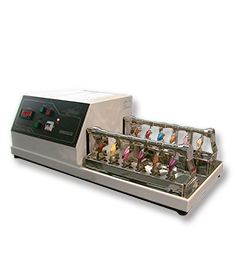
NewsInformation Center
What is the flexometer test for rubber?
2023/11/03
The rubber flexometer is a test method used to evaluate the elasticity and durability of rubber materials. This test is commonly used to determine the bending and deformation properties of rubber materials in actual use and is valuable to manufacturers, researchers and quality controllers.
The principle of the rubber flexometer is to simulate the stress state of a rubber material in actual use by applying repetitive bending loads under certain conditions. In the test, a sample of the material is sandwiched between two support feet and then a bending load is applied at a fixed frequency. By measuring the physical parameters such as deformation and stress of the sample under different loads, the flexural properties of the rubber material can be evaluated.
With the rubber flexometer, the following information can be obtained:
1. bending properties:
The test provides data on the flexural properties of rubber materials under stress. This includes parameters such as flexural stiffness, flexural modulus of elasticity and stress-strain relationships. These data help to understand the bending behavior and stress distribution of rubber materials in actual use.
2. Durability:
The durability and life of a rubber material can be assessed by constantly and repeatedly applying loads. In the test, the deformation and damage of the rubber material under continuous bending load can be observed to determine its durability and longevity.
3. Comparing different materials:
The rubber flexometer can be used to compare the performance of different rubber materials. By testing the flexural properties of different materials, their relative merits and demerits can be assessed and provide a basis for material selection and design.
4. Quality control:
The rubber flexometer can be used for quality control to ensure that manufactured rubber products meet specification requirements. By testing the flexural properties of samples at regular intervals, potential problems can be detected and appropriate action taken to ensure product quality.
When conducting a rubber flexometer, the following points need to be kept in mind:
1. Sample preparation:
The size and geometry of the sample should comply with the relevant standards or application requirements. Ensure that the sample is prepared and mounted in accordance with the requirements of the test.
2. Test conditions:
During testing, appropriate temperature, humidity and loading conditions need to be set to simulate the actual use environment. These conditions can be determined according to the specific application.
3. data analysis:
Once the tests are completed, the data needs to be analyzed and interpreted. This involves calculating and comparing parameters such as flexural stiffness, flexural modulus of elasticity, and evaluating the performance of the sample.
4. calibration and maintenance:
To ensure the accuracy of the test results, flexure instruments need to be calibrated and maintained on a regular basis. Regular inspection and maintenance of the instrument ensures that it is in optimal working condition.
In conclusion, the rubber flexometer is a reliable method for assessing the flexural properties and durability of rubber materials. This test provides important information about the behavior of rubber materials to support the manufacturing and design process and to ensure that products meet quality standards and requirements.
Previous: How is a fogging test conducted in the automotive industry?
N e x t : Which instruments are mostly used for testing fabric thickness?




